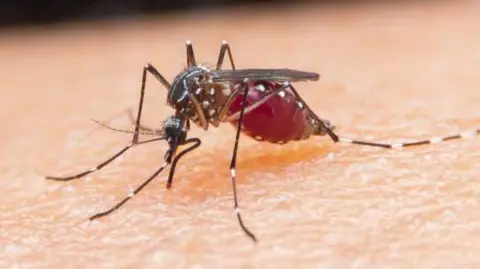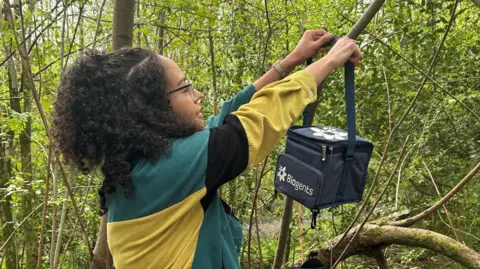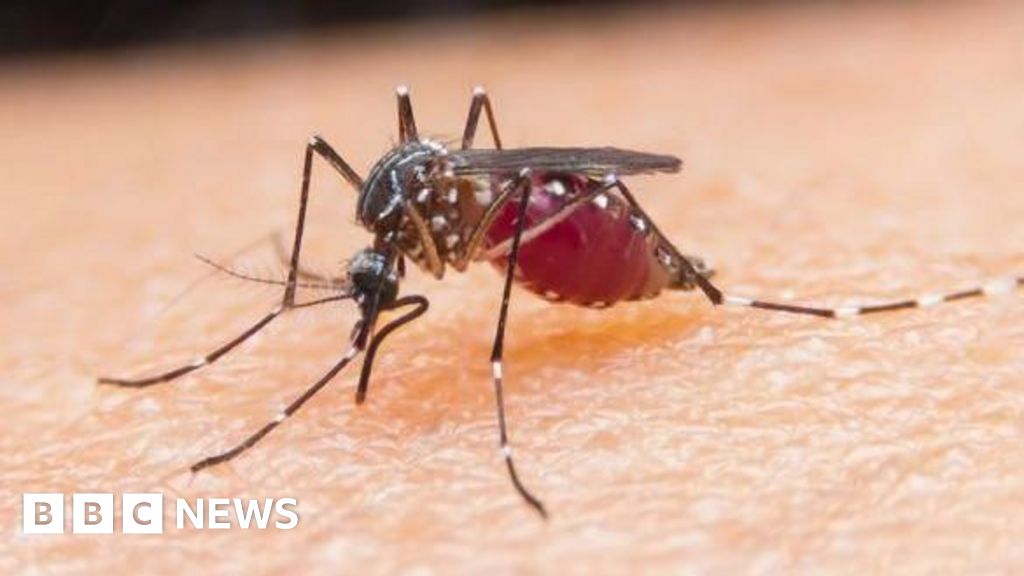Senior Weather Presenter
BBC Scotland News
 BBC
BBCA Scottish summer is synonymous with the humble yet pesky midge.
But Glasgow University scientists have confirmed the continued rise of its distant cousin – the mosquito.
The country is now home to more than 20 different species of the biting insect, and some have been identified in Shetland – the most northern location to date.
More commonly associated with tropical climes, mosquitoes are a natural part of the Scottish ecosystem.
The extent of the mosquito population is being understood thanks to a successful citizen science project.
Midge bite or a mosquito?
 University of Glasgow
University of GlasgowUniversity researchers had received numerous reports from the public of nuisance biting and originally suspected midges or clegs to be responsible.
Further analysis showed the areas in question were swarming with mosquitoes, actively trying to bite people.
Over the last 12 months more than 700 potential sightings and photos were submitted to the ongoing Mosquito Scotland project.
After analysis, more than half were confirmed to be mosquitoes with 21 different species now calling Scotland home.
While sightings from the public were at their peak during the summer, reports were submitted to the team in every month of last year.
The insects are most often spotted in woodland areas, particularly pine forests in the east, though they are often found inland in our biggest cities. In Glasgow larvae was found floating in stagnant water such as garden plant pots and ponds.
Heather Ferguson, professor of medical entomology at the University of Glasgow, described the initial response to their three-year long project as “tremendous”.

She said: ‘We found them to a much greater extent than we’ve known before.
“In almost all parts of the country we got reports of different species. And a very exciting first for us, we found the most northernmost record for the UK when we had a member of the public in Shetland report a mosquito which we were able to confirm.”
In addition to the public sightings, the team hung traps at 24 locations across the country, luring the insects by the smell of carbon dioxide which mimics human breath.
Dr Georgia Kirby leads the citizen science project and said public reporting has guided where they hang the traps, which can sometimes catch more than 1,000 mosquitoes in just two days.
She said: “There were several areas of Scotland where we received lots of reports of bites but very few photos of the culprits – understandably, as most people don’t want to hold still for a photo while they’re being bitten by insects.
“We had suspected that midges or clegs could be responsible, but in our follow-up investigations we invariably found that these locations were swarming with mosquitoes – proving that people in Scotland are good at recognising them and distinguishing them from more familiar insects.
“Most of these sites were areas of dense woodland, which is a key habitat for several aggressive human-biting mosquito species.”

Is malaria a risk?
Mosquitoes don’t currently pose a health risk to humans in Scotland. The parasite needed to spread infectious disease like malaria is not present here.
However, it was a different story 200 years ago when malaria was common in the UK.
It was present in the east of Scotland in particular and spread by native mosquitoes.
Today, climate change is likely to mean we could see more mosquitoes in Scotland, as our climate becomes warmer and wetter – perfect conditions to allow them to thrive.
Culex pipiens, the common house mosquito, has been found to carry and transmit the Usutu virus, originally discovered in the 1950s in Africa and present in Europe for the past three decades.
The virus is spread through the bite of an infected mosquito and has affected blackbird populations.
The Mosquito Scotland project will continue to help track their population and scientists say it will help provide a crucial early warning system for potential risk, as the species respond to environmental change.
Professor Ferguson and Dr Kirby want to hear more from the public in 2025, to help increase their knowledge and build a picture of the biodiversity benefits of mosquitoes and any potential risks.
You can get involved in the project and submit your own sightings by visiting the Mosquito Scotland website.



